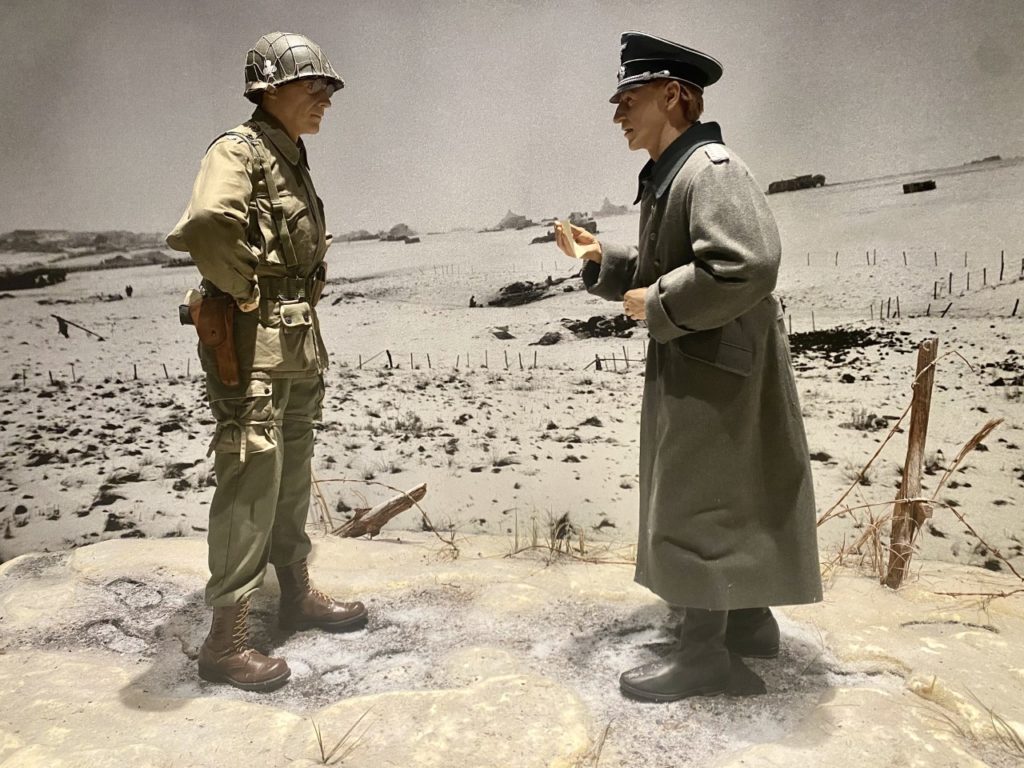The Battle of the Bulge
On December 17, 1944, General Eisenhower ordered XVIII Airborne Corps to move “without delay” to Belgium to help stop a massive German breakthrough that started the day prior. The 82nd Airborne was directed to hold St. Vith and the 101st Airborne Division headed to Bastogne. The 17th Division was ordered from England to Belgium.
Soon, St. Vith and Bastogne were under heavy attack by German tanks and infantry. By December 22, Bastogne was surrounded. The 101st- used to operating behind enemy lines- held Bastogne until relieved on December 26, 1944. Meanwhile, the 82nd’s equally important battle for St. Vith continued until First Army ordered a withdrawal. Fighting from new lines, the 82nd helped turn back the German assault.

The 17th Airborne Division arrived just before Christmas. Their first combat was west of Bastogne and the troopers cleared the area of German units.

The Battle of the Bulge was costly for the Airborne. The 509th Parachute Infantry Battalion had only 55 men left and was inactivated. The 551st Parachute Infantry Battalion had 100 men left and was also inactivated. The men of both battalions transferred to units of the 82nd Airborne Division.
NUTS
On December 22, 1944, during the Battle of the Bulge, the German offensive had surrounded the town of Bastogne, Belgium. Inside the town, Brigadier General McAuliffe commanded the 101st Airborne Division and other tank and artillery units.
That morning, a German contingent approached the 101st under a flag of truce, and handed a surrender ultimatum to Major Alvin Jones, commander of the 2nd Battalion, 327th Glider Infantry Regiment. “The fortune of war is changing,” the typewritten note declared, “Battalions are ready to annihilate the U.S.A. troops in and near Bastogne.” The Germans demanded a surrender within two hours times, or shelling would begin. The Americans, the note said, would be responsible for civilian casualties.
When Jones brought the note to McAuliffe, the general asked him what it said. “They want us to surrender,” said Jones. McAuliffe found the suggestion tactically and morally ludicrous, and he began laughing and exclaimed, “Aw nuts!”
Shortly, McAuliffe took up his pencil and prepared to draft a reply. After a few minutes, the general said aloud, “I don’t know what to tell them.” When McAuliffe asked for suggestions, Lt. Colonel Kinnard, his G-3, replied, “Well, sir, that first remark of yours would be hard to beat.” The entire staff spontaneously applauded. Shortly McAuliffe put his pencil to paper.
To the German Commander:
Nuts!
The American Commander
This was the entire content of the note delivered to the Germans by Colonel Joseph H. Harper, commander of 327th Glider Infantry. In this scene displayed at the ASOM, the German officer is studying the note. A few moments later, Harper took pains to make certain the note was clear. “If you don’t understand what ‘nuts’ means, in plain English, it is the same as, ‘Go to Hell.'”

That night, the German Luftwaffe began a four-night bombing assault against the town. But the Americans refused to give in. On December 26, after a ten-day siege, American tanks from Lieutenant General George Patton’s Third Army lifted the siege of Bastogne.

A Ghost Army Connection
As General George Patton set out to relieve Bastogne during the Battle of the Bulge in December 1944, he received vital assistance from a top-secret deception unit; the 23rd Headquarters Special Troops (AKA The Ghost Army). This handpicked group of Soldiers used inflatable tanks, sound effects, radio trickery and other forms of illusion to fool the Germans about the strength and location of American units. From Normandy to the Rhine, they carried out 22 different battlefield deceptions, working with Patton at several key junctures.
Activated on January 20, 1944, the unique and top-secret Ghost Army unit was comprised of 82 officers and 1,023 men. Under the command of Army veteran Colonel Harry L. Reeder, the group was capable of simulating two whole divisions (approximately 30,000 men) by using visual, sonic and radio deception to fool German forces during the final year of World War II.
“The Ghost Army staged 22 deception operations in France, Belgium, Luxembourg and Germany, often operating dangerously close to the front lines. ‘Its complement was more theatrical than military,’ noted the unit’s official history. ‘It was like a traveling road show that went up and down the front lines impersonating the real fighting outfits.’ They frequently put themselves in danger, suffering casualties as a consequence. Three Ghost Army soldiers were killed and dozens wounded carrying out their missions. As the Allies moved inland through Normandy, as Patton broke out of the hedgerows and raced across France, as General Bradley ordered the relief of Bastogne during the Battle of the Bulge, the Ghost Army was there, playing an unsung role.”
Rick Beyer, Writer and Producer of the documentary, “The Ghost Army”
The Ghost Army exhibit that featured a life-sized inflatable tank was previously on display at the ASOM, December 15, 2020 through April 25, 2021.
If you enjoyed this content, please consider giving a gift to the ASOM to help us continue our mission of educating the public on the legacies of Airborne and Special Operations Soldiers.



